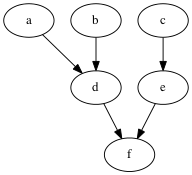course-web-page-fall-2022
Course web page for Data Structures H343 Fall 2022
View the Project on GitHub IUDataStructuresCourse/course-web-page-fall-2022
Lecture: Graphs and Topological Sorting
The standard mathematical way to represent a graph G is with a set of vertices V and a set of edges E, that is, G = (V,E).
In a directed graph, each edge is a pair of vertices where the first vertex is called the source and the second is the target.
In an undirected graph, each edge is a set containing two distinct vertices.
I often use n for the number of vertices and m for the number of edges.

The set of vertices for this graph is
{0,1,2,3,4,5}.
The set of edges is
{(0,0), (1,2),(1,4), (2,5), (3,5),(3,0), (4,2), (5,4), }.
Given edge (u,v) in a directed graph, we say v is adjacent to u. We sometimes write u to v for the edge (u,v).
The edge (u,v) is an out-edge of u and an in-edge of v.
The out-degree of a vertex is the number of its out-edges.
The in-degree of a vertex is the number of its in-edges.

The set of vertices is {0,1,2,3,4}.
The set of edges is { {1,2},{1,0}, {2,3},{2,4},{2,0}, {3,4}, {4,0} }.
We often writes an undirected edge as (1,2) or 1-2 instead of {1,2}.
Given edge {u,v} in an undirected graph, we say u and v are
adjacent to each other.
We say that edge {u,v} is incident on vertex u and v.
The degree of a vertex is the number of edges incident on it.
Adjacency List
The Adjacency List representation of a graph is an array of linked lists.
Example: for the above directed graph the adjacency list representation is
|0| -> 0
|1| -> 2 -> 4
|2| -> 5
|3| -> 0 -> 5
|4| -> 2
|5| -> 4
Example: for the above undirected graph the adjacency list representation is
|0| -> 1 -> 2 -> 4
|1| -> 0 -> 2
|2| -> 1 -> 4 -> 3 -> 0
|3| -> 2 -> 4
|4| -> 0 -> 3 -> 2
(Each edge is stored twice.)
Adjacency lists are good for storing sparse graphs.
- Space: O(n + m).
- Edge detection given two vertices: O(n)
- Edge insert: O(1)
- Edge removal given two vertices: O(n)
- Edge remove given edge handle: O(1) if use double linked
- Edge removal: O(n) or O(1) if use double linked and edge handle
- Vertex insert: amortized O(1)
- Vertex delete: not easily supported
Adjacency Matrix
The Adjacency Matrix representation of a graph is a Boolean matrix.
Example, for the directed graph above.
0 1 2 3 4 5
0 1 0 0 0 0 0
1 0 0 1 0 1 0
2 0 0 0 0 0 1
3 1 0 0 0 0 1
4 0 0 1 0 0 0
5 0 0 0 0 1 0
Example, for the undirected graph above.
0 1 2 3 4
0 0 1 1 0 1
1 1 0 1 0 0
2 1 1 0 1 1
3 0 0 1 0 1
4 1 0 1 1 0
Note that the matrix is symmetric.
Adjacency matrices are good for dense graphs.
- Space: O(n²)
- Edge detection given two vertices: O(1)
- Edge insert: O(1)
- Edge removal given two vertices: O(1)
- Edge remove given edge handle: O(1)
- Edge removal: O(1)
- Vertex insert: amortized O(1)
- Vertex delete: not easily supported
How could we represent Adjacency Matrices in Java?
Topological sorting
Makefile example for building software (a) zig.cpp (b) boz.h (c) zag.cpp (d) zig.o (e) zag.o (f) libzigzag.a

- Is this a well-formed dependence graph, are there any cycles?
- In what order should they be compiled?
- How many steps are required to compile everything in parallel?
Recall that a topological ordering is an ordering A of the vertices
such that if A[i] -> A[j], then i < j.
In other words, a vertex needs to come before every other vertex that depends on it.
Here are many (all?) of the topological orderings:
a,b, c, d,e, f
b,a, c, d,e, f
a,b, c, e,d, f
b,a, c, e,d, f
a,b, d, c,e, f
b,a, d, c,e, f
c,e, a,b, d, f
c,e, b,a, d, f
Knuth’s version of Kahn’s algorithm for topological sort
static <V> void topo_sort(Graph<V> G,
Consumer<V> output,
Map<V,Integer> num_pred) {
// initialize the in-degrees to zero
for (V u : G.vertices()) {
num_pred.put(u, 0);
}
// compute the in-degree of each vertex
for (V u : G.vertices())
for (V v : G.adjacent(u))
num_pred.put(v, num_pred.get(v) + 1);
// collect the vertices with zero in-degree
LinkedList<V> zeroes = new LinkedList<V>();
for (V v : G.vertices())
if (num_pred.get(v) == 0)
zeroes.push(v);
// The main loop outputs a vertex with zero in-degree and subtracts
// one from the in-degree of each of its successors, adding them to
// the zeroes bag when they reach zero.
while (zeroes.size() != 0) {
V u = zeroes.pop();
output.accept(u);
for (V v : G.adjacent(u)) {
num_pred.put(v, num_pred.get(v) - 1);
if (num_pred.get(v) == 0)
zeroes.push(v);
}
}
}
Time Complexity of Topological Sort (Knuth’s version)
-
Compute in-degrees
Outer loop processes every vertex: O(n)
Outer + inner loop processes every edge: O(m)
Total: O(n + m)
-
Collect vertices with zero in-degree: O(n)
-
Main loops (while + for) processes each edge just once: O(m)
Total: O(n + m) or because m in O(n²), total is O(n²).
Student Exercise
topologically sort the following graph
V = { belt, jacket, pants, socks, shoes, shirt, tie, undershorts, watch }
E = { belt -> jacket,
pants -> shoes, pants -> belt,
socks -> shoes,
shirt -> tie, shirt -> belt,
tie -> jacket,
undershorts -> pants, undershorts -> shoes }
solution: (one of many)
socks, undershorts, pants, shoes, watch, shirt, belt, tie, jacket